This guide walks you through the steps to deploy and provision the Barracuda Email Security Gateway on Microsoft Azure using either the Azure Resource Manager Model or the Classic Model.
Deploying and Provisioning the Barracuda Email Security Gateway Using the Azure Resource Manager Model
Perform the following steps to deploy and provision the Barracuda Email Security Gateway using Resource Manager in the new Microsoft Azure portal:
- Log into the Microsoft Azure Management Portal.
- Click Marketplace at the bottom of the screen.
- In the Everything page, enter Barracuda Email Security Gateway in the text field.
- In the search results, select Barracuda Email Security Gateway (BYOL or PAYG as per your requirement).
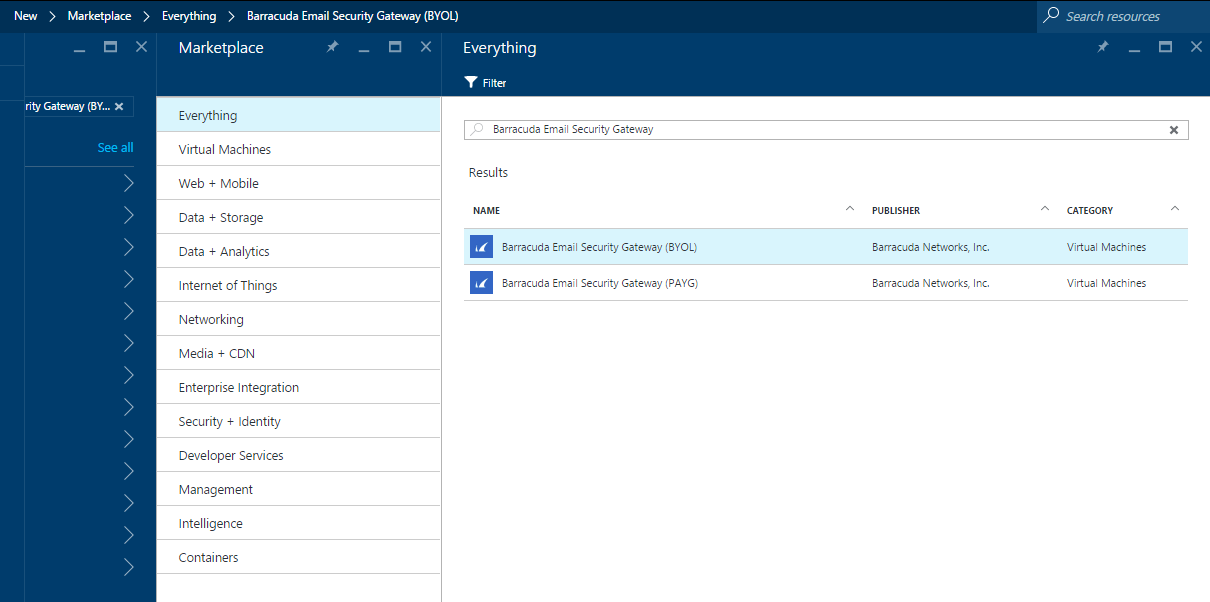
- In the Bring Your Own License enabled/Free Trial enabled page:
- Read the product overview.
- Select Resource Manager as a deployment model from the Select a deployment model drop-down list.
- Click Create.
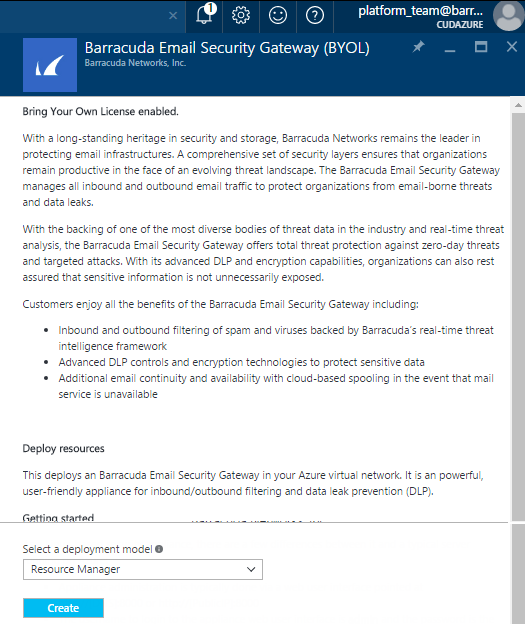
- In the Create virtual machine > 1 Basics page:
- Name: Enter a name for the virtual machine.
- User name: Enter a username. Note: This entry is not used by the Barracuda Email Security Gateway.
- Authentication Type: Choose Password and enter a password for the authentication. Note that this will be your password to access the Barracuda Email Security Gateway web interface.
- Resource Group: Create a new resource group or select a resource group from the existing Resource group list.
- Location: Select a location for the resource group.
- Click OK.
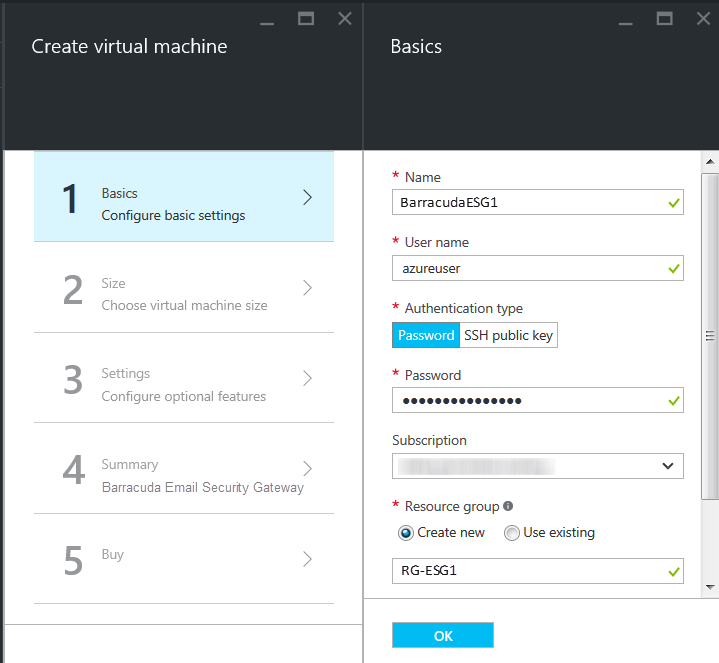
- In the Create virtual machine > 2 Size page, select a size for the instance and click Select.
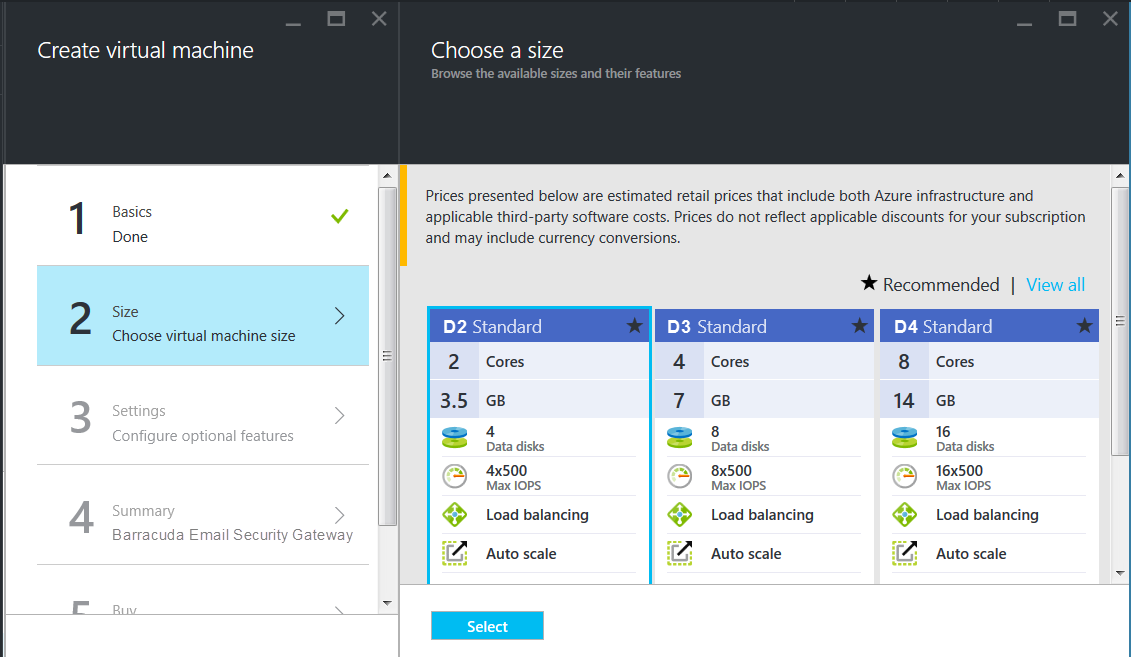
- In the Create virtual machine > 3 Settings page:
- Storage
- Data type: Select Standard/Premium (SSD) as per your requirement.
- Storage account: Create a new storage account or select a storage account from the existing Storage account list.
- Network
- Virtual network: Configure or select the network in which you want to deploy the Barracuda Email Security Gateway.
- Subnet: Configure or select the subnet in which you want to deploy the Barracuda Email Security Gateway.
- Public IP address: Configure or select the public IP address to the Barracuda Email Security Gateway.
- Network security group: By default, port 8000 (TCP), port 443 (TCP) and port 25 (TCP) will be opened as in your Security Group. Configure additional rules if required.
- Extensions
- Extensions: Do not add any extension, as the Barracuda Email Security Gateway does not support extensions.
- Availability
- Availability set: Create an availability set or select an availability set from the existing Availability set list. Note: If you intend to use this virtual machine in cluster, ensure all virtual machines in cluster is configured with same availability set.

- Availability set: Create an availability set or select an availability set from the existing Availability set list. Note: If you intend to use this virtual machine in cluster, ensure all virtual machines in cluster is configured with same availability set.
- Storage
- In the 4 Summary page, review the configuration settings and click OK.

- In the 5 Buy page, read the legal terms and click Purchase to complete the deployment.
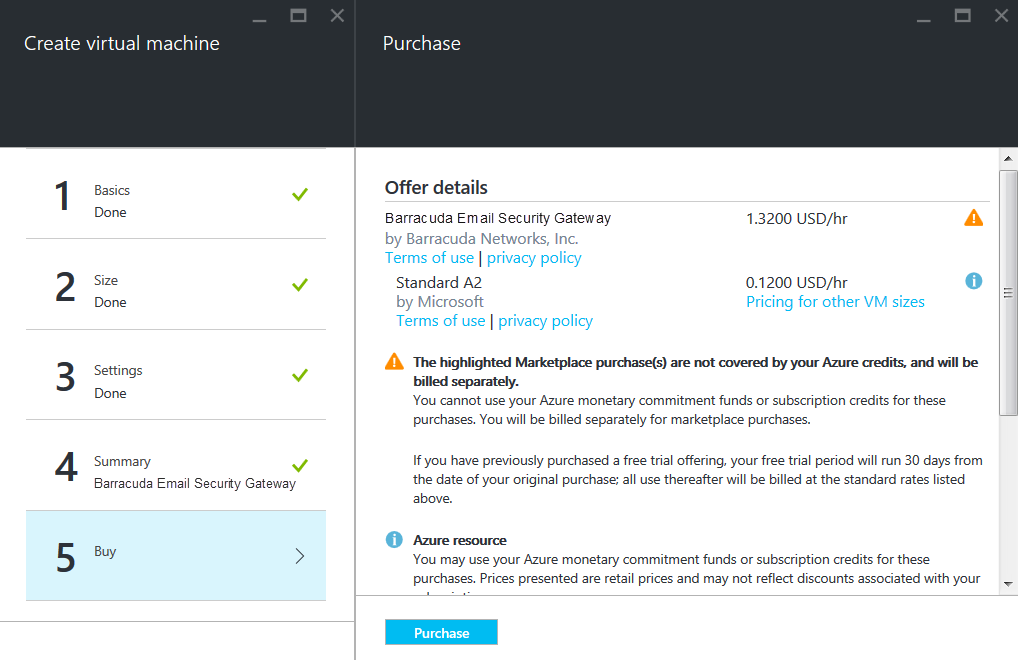
After clicking Purchase, Microsoft Azure begins provisioning the Barracuda Email Security Gateway. You can check the status of the provisioned Barracuda Email Security Gateway from the Microsoft Azure Portal. Allow a few minutes before taking any further actions in the Portal. During this time, the Microsoft Azure Linux Agent and Barracuda Email Security Gateway image boots up.
Make sure you do not restart the Barracuda Email Security Gateway while it is provisioning.
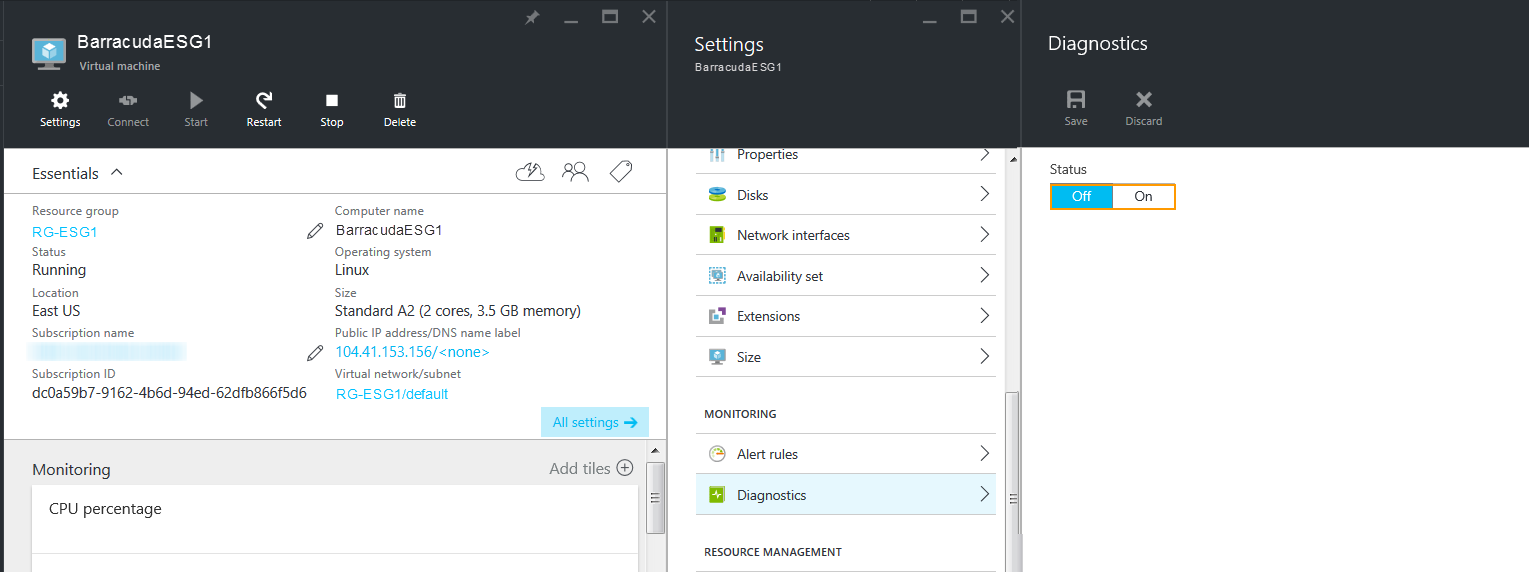
Deploying and Provisioning the Barracuda Email Security Gateway Using the Classic Model
Perform the following steps to deploy and provision the Barracuda Email Security Gateway using the classic deployment model in the new Microsoft Azure portal:
- Log into the Microsoft Azure Management Portal.
- Click Marketplace at the bottom of the screen.
- In the Everything page, enter Barracuda Email Security Gateway in the text field.
In the search results, select Barracuda Email Security Gateway (BYOL or PAYG as per your requirement). - In the Bring Your Own License enabled/Free Trial enabled page:
- Read the product overview.
- Select Classic as a deployment model from the Select a deployment model drop-down list.
- Click Create.
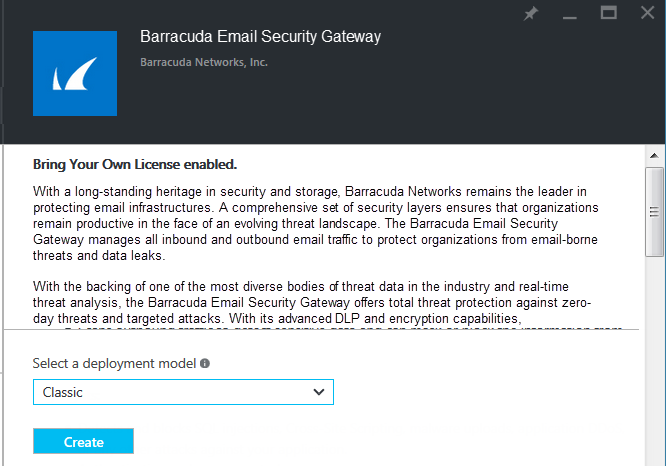
- In the Create virtual machine > 1 Basics page:
- Name: Enter a name for the virtual machine.
- User name: Enter a username. Note: This entry is not used by the Barracuda Email Security Gateway.
- Authentication type: Choose Password and enter a password for the authentication. Note that this will be your password to access the Barracuda Email Security Gateway web interface.
- Confirm password: Re-enter the password to confirm.
- Subscription: Select the subscription from the drop-down list.
- Resource group: Create a new resource group or select a resource group from the existing Resource group list.
- Location: Select a location for the resource group.
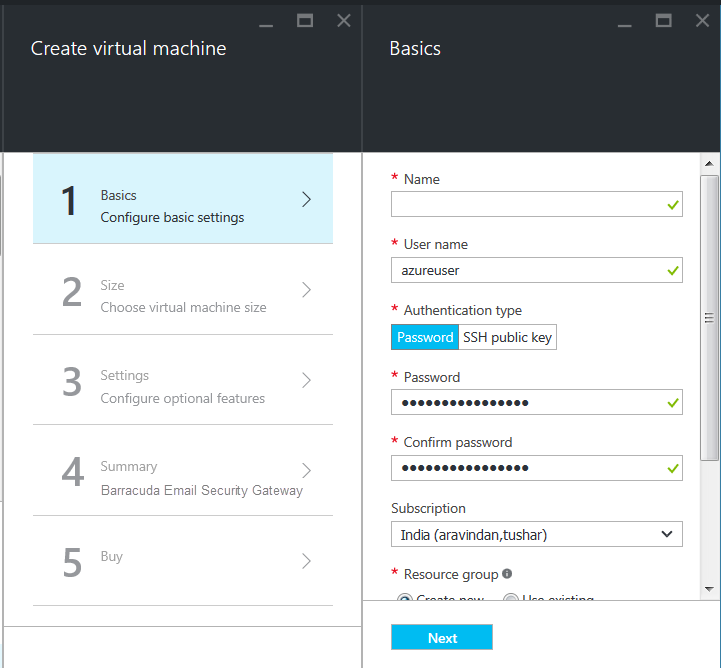
- In the Create virtual machine > 2 Size page:
- Select a size for the instance and click Select.
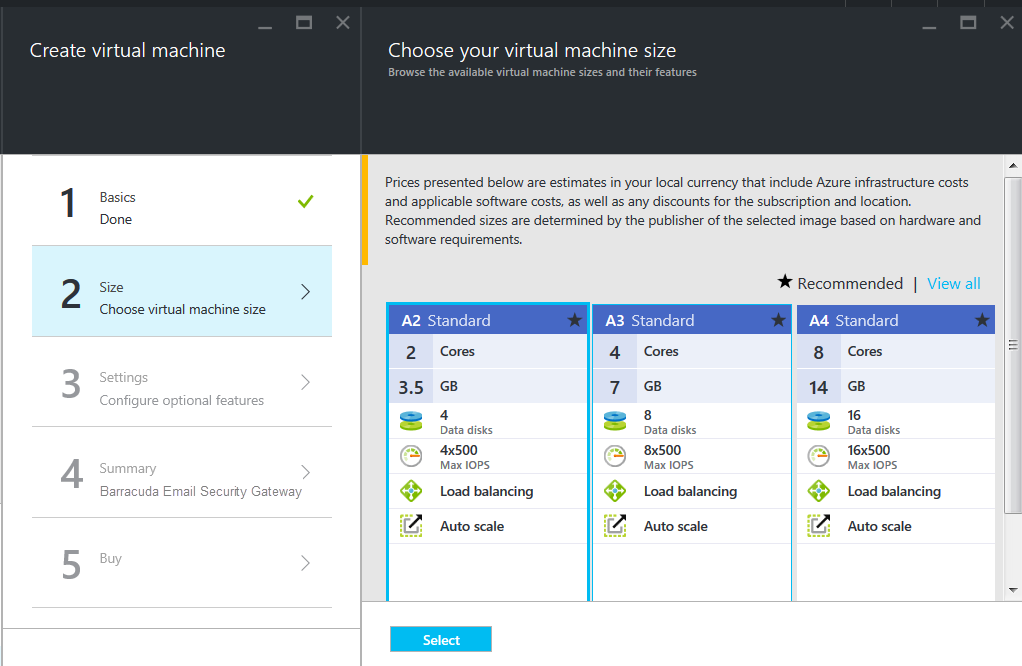
- Select a size for the instance and click Select.
- In the Create virtual machine > 3 Settings page:
- Storage
- Data type: Select Standard/Premium (SSD) as per your requirement.
- Storage account: Create a new storage account or select a storage account from the existing Storage account list.
- Network
- Domain name: Enter the domain name for the Barracuda Email Security Gateway VM.
- Virtual network: Configure or select the network in which you want to deploy the Barracuda Email Security Gateway.
- Subnet: Configure or select the subnet in which you want to deploy the Barracuda Email Security Gateway.
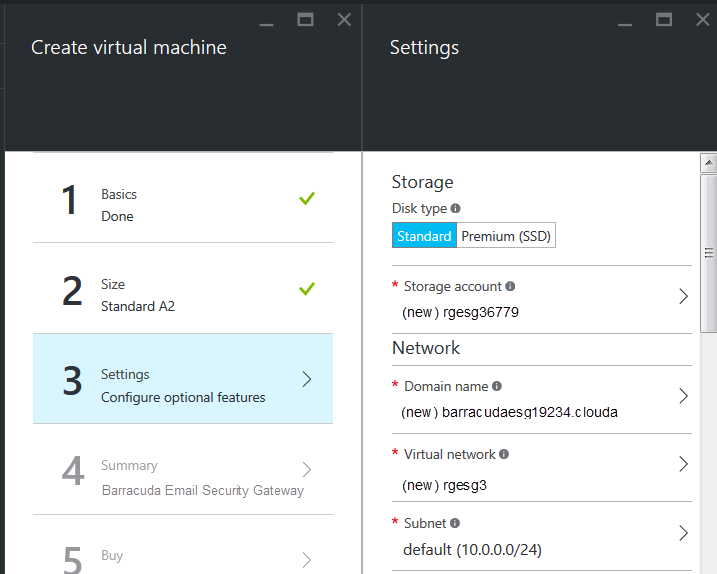
- Private IP address: Select Dynamic/Static.
- Dynamic to auto assign the private IP address to the Barracuda Email Security Gateway.
- Static to configure the static private IP address to the Barracuda Email Security Gateway.
- Virtual IP address: Select Assign a new reserved IP address/Dynamic IP address. The instance can be accessed from outside the virtual network using this virtual IP address. Ensure that at least one endpoint is configured.
- Assign a new reserved IP address: Specify a name for the virtual IP address assigned by the Microsoft Azure.
- Dynamic IP address: Select to auto assign the virtual IP address for the Barracuda Email Security Gateway.
- Endpoints: Add the port 8000 (TCP), port 443 (TCP) and port 25 (TCP) as your endpoints.
- Extensions
- Extensions: Do not add any extension, as the Barracuda Email Security Gateway does not support extensions.
- Availability
- Availability set: Create an availability set or select an availability set from the existing Availability set list. Note: If you intend to use this virtual machine in cluster, ensure all virtual machines in cluster is configured with same availability set.
- In the 4 Summary page, review the configuration settings and click OK.
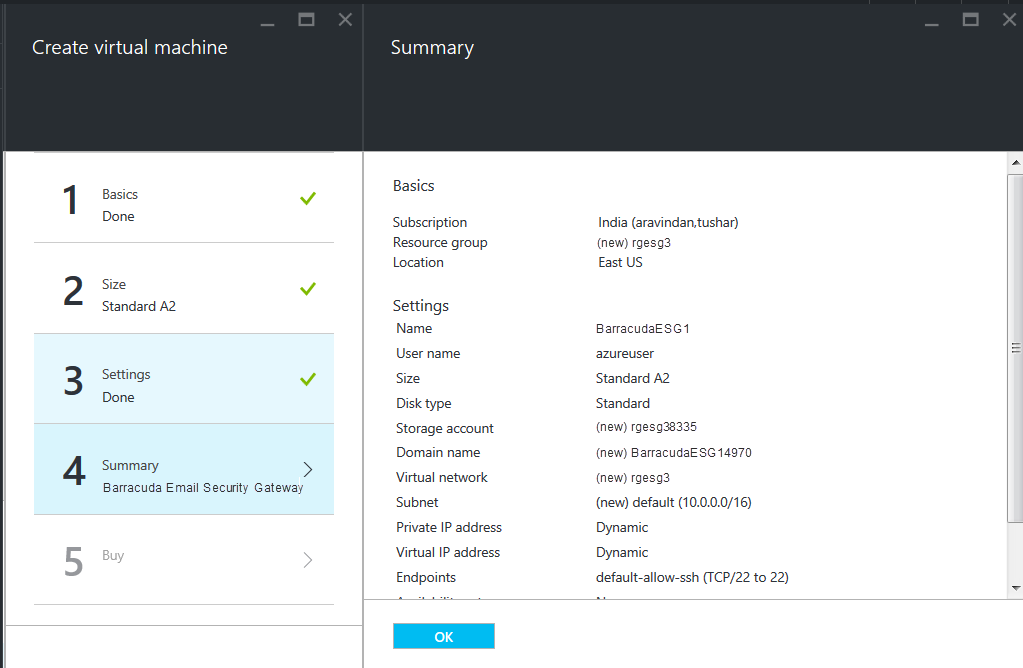
- In the 5 Buy page, read the legal terms and click Purchase to complete the deployment.
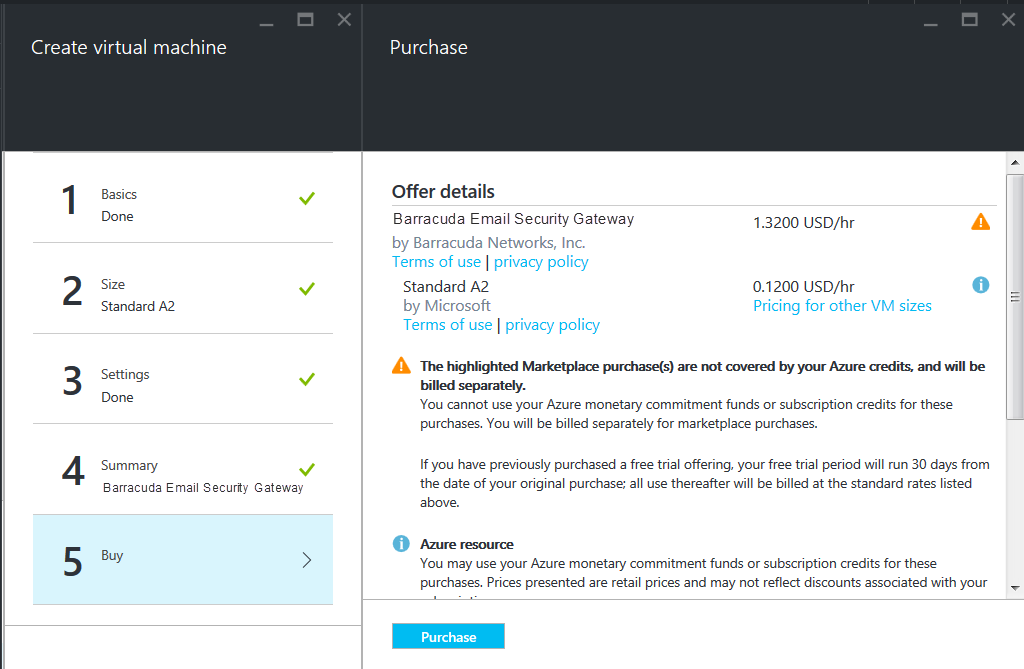
After clicking Create, Microsoft Azure begins provisioning the Barracuda Email Security Gateway. You can check the status of the provisioned Barracuda Email Security Gateway from the Microsoft Azure Portal. Allow a few minutes before taking any further actions in the Portal. During this time, the Microsoft Azure Linux Agent and Barracuda Email Security Gateway image boots up.
Make sure you do not restart the Barracuda Email Security Gateway while it is provisioning.
Next Step
Continue with the Barracuda Email Security Gateway Quick Start Guide on Microsoft Azure for licensing and initial configuration of your virtual machine
